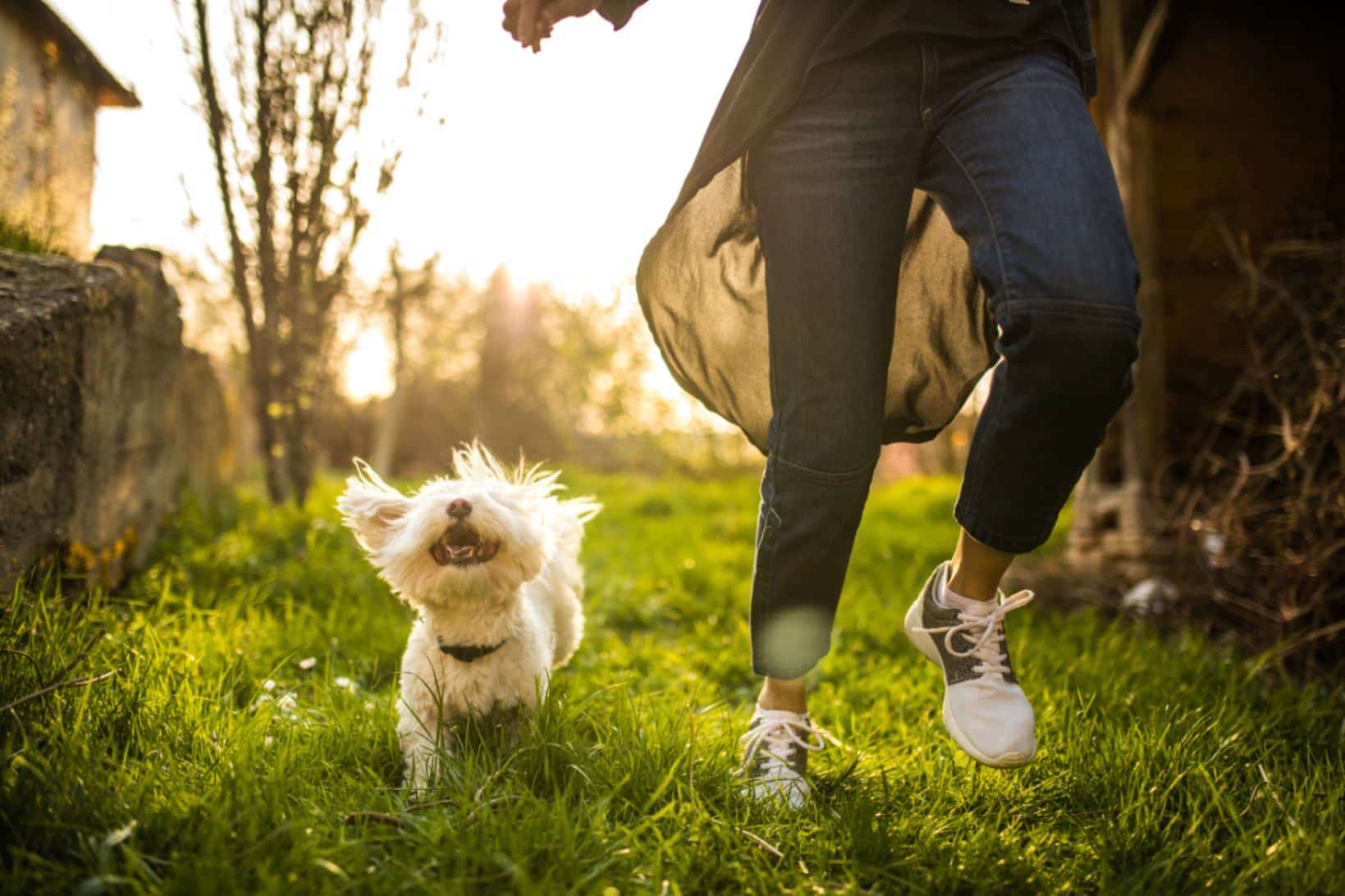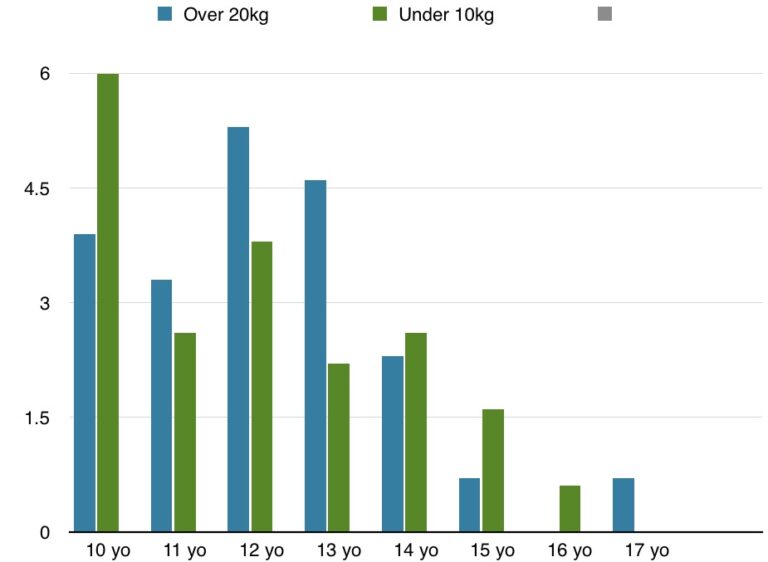Small Dog Walking: Optimal Duration for a Healthy Pup
Last Updated on May 14, 2024 by Petpalace54
Small dogs should be taken for a walk for at least 15-20 minutes. Walking is important to maintain their physical and mental health. Regular exercise will also prevent them from developing health problems and behavioral issues. How long should you need Small Dog Walking? As a pet owner, it is essential to dedicate enough time to your furry friend’s walks. Taking your small dog for a daily walk not only ensures their overall well-being but also strengthens your bond.
Actually, apart from physical activity, dogs need to socialize and explore the world around them. Walking is therefore an ideal way for them to sniff and discover new things. Adequate walks will also prevent small dogs from getting bored, anxious, and aggressive behaviors. The duration of walks depends on the breed, age, & energy level of the dog. Consult your veterinarian to ensure you meet your dog’s exercise needs.
Table of Contents
- 1 Importance Of Walking For Small Dogs
- 2 Factors Affecting Optimal Duration
- 3 Recommended Daily Walking Duration
- 4 Signs Of Overexercising
- 5 Alternatives To Walking
- 6 Precautions To Take
- 7 Examples Of Ideal Walking Schedules
- 8 Frequently Asked Questions For How Long Should You Take A Small Dog For A Walk
- 9 Conclusion
Importance Of Walking For Small Dogs
Walking is an essential activity that helps small dogs stay healthy and happy. Regular walks not only help keep them physically fit but also provide the mental & emotional stimulation that they need to thrive. However, the question that most small dog owners often have is: how long should I take my small dog walking? In this post, we will look at the importance of walking for small dogs and the ideal duration of a walk.
Physical Health Benefits
Walking provides numerous physical health benefits for small dogs. Here are some of the key benefits:
| Benefit | Description |
| Weight Management | Walking helps small dogs maintain a healthy weight and reduce the risk of obesity. Regular walks burn calories and fat, which is vital for maintaining a healthy body weight. |
| Muscle Development | Walking helps develop and maintain muscles in small dogs. Regular walks strengthen muscles and improve their overall physique. |
| Cardiovascular Health | Walking boosts cardiovascular health by improving blood circulation, reducing blood pressure, & strengthening the heart. Regular walks also reduce the risk of heart disease and other cardiovascular complications. |
| Bone & Joint Health | Walking helps improve bone & joint health by providing low-impact exercise that strengthens bones and joints. Regular walks also reduce the risk of osteoporosis and arthritis. |
Mental Health Benefits
Walking also provides numerous mental health benefits for small dogs. Here are some of the key benefits:
- Reduced Stress & Anxiety: Walking provides small dogs with an opportunity to explore new surroundings, meet new people, and interact with other dogs. These social interactions help reduce stress and anxiety.
- Mental Stimulation: Walking provides mental stimulation by exposing small dogs to new sights, smells, and sounds. This helps keep them mentally active & prevent boredom.
- Bonding: Walking provides an excellent opportunity for bonding between small dogs & their owners. Regular walks help strengthen the bond between them.
So, how long should you take your small dog for a walk? The ideal duration of a walk depends on various factors, such as age, breed, fitness level, and health condition. In general, small dogs require at least 30 minutes of exercise every day. However, you should consult your vet to determine the ideal duration of a walk for your small dog.
Factors Affecting Optimal Duration
Walking your small dog is a fantastic way to bond, exercise, and explore the great outdoors. That being said, you might be wondering how long should you take a small dog for a walk. As with most things, there is no definitive answer, as it depends on a variety of factors, including:
Breed & Size
The breed and size of your dog play a significant role in how long you should take them out for a walk. For instance, a small dog breed like the Chihuahua may be content with a short 15 to 20-minute trip around the block, while a larger dog breed, like the Labrador Retriever, may require a longer 45 to 60-minute stroll through the park.
If your dog is a mixed breed, a good rule of thumb is to consider the largest breed in their genetic makeup when you estimate your pup’s optimal walk duration.
Age & Health Conditions
The age and health conditions of your dog also factor into the length of their walk. If your dog is a puppy, you’ll want to gradually increase their walk time as they grow and develop. Senior dogs may require shorter strolls, particularly if they are in arthritic pain or have other mobility issues, while an energetic, healthy dog may enjoy a lengthier adventure.
Weather & Temperature
Weather and temperature are also essential considerations when planning your dog’s optimal walk duration. Extreme heat or cold can present risks to your pup’s health. In warm weather, it may be best to limit your walks to early morning or evening hours and always bring water for both you and your dog. In colder climates, consider shorter walks or investing in protective gear for your pups, such as a coat or booties.
Keeping these factors in mind will help you plan the perfect walk for your small dog. Remember to always pay attention to your pup’s behavior during & after their walk to make sure they are comfortable and content.
Recommended Daily Walking Duration
If you’re a small dog owner, then you’ve probably wondered how long you should be walking your furry friend. Many small dog breeds, such as Chihuahuas, Dachshunds, and Pomeranians, have plenty of energy to burn & require daily walks to stay happy and healthy.
General Guideline
A general guideline for small dog walking duration is at least 30 minutes of exercise each day. However, this number can vary based on several factors, including age, weight, and breed.
Specific Recommendations For Breeds
Each breed of small dog has its unique characteristics, which affect how much exercise it needs. For instance:
| Breed | Duration |
|---|---|
| Chihuahua | 15-30 minutes |
| Pomeranian | 20-30 minutes |
| Yorkshire Terrier | 20-30 minutes |
| Boston Terrier | 30-45 minutes |
| French Bulldog | 30-45 minutes |
| Shih Tzu | 30-45 minutes |
| Cavalier King Charles Spaniel | 30-60 minutes |
| Pug | 30-60 minutes |
| Jack Russell Terrier | 45-60 minutes |
| West Highland White Terrier | 45-60 minutes |
However, it’s essential to keep in mind that these recommendations are just general guidelines, and each dog’s needs will vary. Some dogs may need more exercise, while others may require less, depending on their age, health, & energy levels.
When taking your small dog for a walk, make sure to pay attention to their body language and keep an eye out for signs of fatigue or discomfort. Always carry plenty of water, especially during hot weather, and be mindful of the surfaces you’re walking on, as small dogs are more susceptible to injuries from pavement, concrete, & other hard surfaces.

Credit: www.usatoday.com
Signs Of Overexercising
Overexercising small dogs can lead to fatigue, lameness, and even injuries, so it’s important to know how much exercise your furry friend needs. Signs of overexercising include limping, panting, & reluctance to move. It’s recommended to take small dogs for a 15-30 minute walk once or twice a day.
As a pet owner, it’s important to ensure that your pup gets enough exercise to stay healthy and happy. However, it’s equally important to ensure that they don’t get overexercised, which can be detrimental to their health. In this section, we’ll be discussing the signs of overexercising and how long you should take a small dog for a walk.
Physical Symptoms
Overexercising can lead to a host of physical symptoms in your furry friend. Some of the most common ones include:
- Panting: Dogs that are overexerted will often pant excessively
- Weakness: If your pup seems weak or lethargic after exercise, it may be a sign that they’ve overdone it
- Limping: Overexercising can also lead to limping or other mobility issues
- Dehydration: If your dog is overexercised, they may become dehydrated, which can cause a range of health problems
If your pup displays any of these symptoms following exercise, it might be time to dial back their walks and give them some rest.
Behavioral Changes
In addition to physical symptoms, overexercising can also lead to behavioral changes in your pet. Here are a few things to look out for:
- Loss of appetite: If your pooch’s appetite decreases after exercise, it might signal that they’re overexerted
- Agitation: Dogs that are overexerted can become agitated or anxious
- Excessive licking: Overexertion can also cause pups to start licking themselves excessively
- Vocalization: Finally, overexercised dogs may also start vocalizing more than usual
If you notice any of these behavioral changes, it’s a clear indication that your pet has been overexerted during exercise.
In conclusion, it’s essential to be aware of the signs of overexercising to ensure that your pets remain active, healthy, and safe. As for the length of walks, it varies depending on your dog’s breed, age, and overall health status. It’s best to consult a vet to determine your pet’s specific needs. By paying attention to your pup’s physical & behavioral cues, you’ll be able to strike a balance between keeping them active and avoiding overexertion.
Alternatives To Walking
Dogs need regular exercise to maintain good health and wellbeing. Small dogs need exercise just as much as larger dogs, but for a shorter duration. The question is, how long should you take a small dog for a walk? Walking isn’t the only exercise option for small dogs. There are several indoor exercises, interactive toys, and games that can provide your small dog with the necessary physical activity requirements.
Indoor Exercises
There are several indoor exercises that small dogs can do to maintain their physical health. Some of these exercises include:
- Stair climbing: Encourage your small dog to climb up and down the stairs a few times. This exercise will help improve your dog’s leg strength & overall health.
- Dancing: Turn on some music and get your small dog dancing with you. Dancing is an excellent way to get your dog’s heart pumping & burn off some extra calories.
- Hide and seek: Hide a few treats or toys around the house and encourage your small dog to find them. This exercise will help improve your dog’s hunting instincts & provide good mental stimulation.
- Treadmill: If you have a treadmill at home, you can train your small dog to walk on it. Start slowly and gradually increase the speed as your dog gets used to it.
Interactive Toys And Games
Interactive toys and games are an excellent way to provide your small dog with the necessary physical activity. These toys and games are designed to keep your dog active and provide them with mental stimulation. Here are some interactive toys and games you can consider:
- Tug of war rope toy: This toy is perfect for small dogs. It is an excellent way to improve your dog’s strength & provide them with good dental stimulation.
- Puzzle toys: These toys come in different shapes and sizes and require your dog to solve puzzles to get a treat or toy. Puzzle toys provide good mental stimulation & strengthen your dog’s jaws.
- Fetch: Playing fetch is an excellent way to get your small dog moving. Chasing a toy or ball will provide your dog with good cardiovascular exercise.
- Interactive treat dispenser: This toy dispenses treats when your dog interacts with it. It is an excellent way to keep your dog engaged & mentally stimulated.
In conclusion, walking isn’t the only exercise option for small dogs. There are several indoor exercises, interactive toys, and games that can provide your small dog with the necessary physical activity. Choose an activity that your small dog enjoys and make it part of their daily routine. Always consider your small dog’s age, health, & fitness level when choosing an exercise program for them.

Credit: www.amazon.com
Precautions To Take
While having a furry friend to walk with can be a joy in itself, taking your pet out for a daily walk comes with its own set of responsibilities. Dog owners must be aware of the different precautions to take before going for a walk. As a responsible pet owner, you must not only consider the dog’s needs but also ensure its safety during the walk. In this section, we’ll discuss important precautions to take when taking small dogs for walks.
Safety Measures
The safety of small dogs can be a significant concern during walks. As small dogs are more vulnerable to attacks or sickness, it’s important to take adequate safety measures to avoid any unpleasant incidents. Here are some safety measures to consider:
- Always use a leash: You may think that your dog is well-trained, but anything can happen if it gets distracted. Walking without a leash can be dangerous for both the dog and the owner.
- Invest in a harness: Collars can cause neck injuries, especially if your dog pulls or jerks. Look for a harness with padding around the chest and back. It will help keep your dog comfortable while you walk.
- Carry water & a bowl: Dogs get thirsty too, and a long walk can leave them feeling dehydrated. Carry water and a collapsible bowl to keep them hydrated throughout the walk.
- Check the temperature of the pavement: As small dogs are low to the ground, they’re more susceptible to burns on their paws from hot sidewalks. If the pavement is too hot to touch, it’s too hot for your dog’s paws. Look for alternative surfaces or walk during cooler times of the day.
- Make sure your dog is visible: If you’re walking in a busy area, make sure your dog is visible. Invest in a reflective collar or a vest to make your dog visible in low-light conditions.
Environmental Concerns
The environment can also pose a threat to your dog’s safety and health during walks. It’s important to be aware of the environmental concerns that you may come across. Here are a few things to keep in mind:
- Keep your dog away from plants and flowers. While plants such as lilies and daffodils can be beautiful, they’re toxic to dogs. Always keep your small dog away from plants & flowers that you’re not familiar with.
- Watch out for wildlife. Small dogs can easily get scared or injured by other animals. Keep your dog close to you to avoid encounters with raccoons, skunks, or other animals.
- Be careful around bodies of water. Dogs love to swim, but not all dogs are good swimmers. Keep your small dog away from deep water bodies, rocky areas, & strong currents.
- Pick up after your dog. Always carry poop bags with you and pick up after your dog. Not only is it courteous to others, but it also helps keep the environment clean & healthy for everyone.
Generally, taking your small dog for a walk can be a joyful experience when the necessary precautions are taken. Always prioritize your dog’s safety, stay vigilant, & be responsible.
Examples Of Ideal Walking Schedules
Small dogs should be taken for a walk at least 30 minutes a day, but the ideal walking schedule will depend on the dog’s breed, age, and health. For example, a young, energetic dog may need more frequent and longer walks, while an older dog with health issues may require shorter, slower-paced walks.
Small dogs may have tiny legs, but they have a lot of energy to burn. As a responsible pet owner, it’s important to ensure that your furry friend gets enough exercise to stay healthy and happy. One of the best ways to do this is by taking them for walks every day. But how long should you take a small dog for a walk? Here are some examples of ideal walking schedules that you can follow to keep your four-legged companion in good spirits.
Morning Walks
Morning walks are a great way to start the day for both you and your dog. The cool morning air can help your pet wake up and feel refreshed. Ideally, you should aim for a walk of at least 20 to 30 minutes to get your dog’s heart pumping & their muscles stretched. This will help them feel energized and ready to take on the day ahead. If you live in a busy area, try to avoid rush hour so you and your pet can enjoy a peaceful walk.
Afternoon Walks
Afternoon walks can be a bit more challenging due to the heat, so it’s best to avoid taking your dog out during the hottest parts of the day. Instead, try to plan your walk for early afternoon or late afternoon when the temperature is cooler. A 20-minute walk is usually enough to keep your dog happy and healthy. If you can’t manage a walk during the day, consider hiring a dog walker to take your pet out while you’re at work.
Evening Walks
Evening walks are a great way to wind down at the end of the day. The cooler temperatures and peaceful atmosphere can be a welcome break after a long day. A 30-minute walk is ideal for this time of day, as it will help your dog relax & burn off some of their excess energy before bed. Be sure to bring a flashlight or reflective gear if you’re walking in the dark, and avoid areas that may be busy or noisy.
In conclusion, small dogs need regular exercise to stay healthy and happy. By following these examples of ideal walking schedules, you can help ensure that your four-legged friend gets the exercise they need to thrive. Remember to always bring water, poop bags, & treats, and be sure to keep your dog on a leash for safety purposes. Happy walking!
:strip_icc()/best-dog-breeds-for-busy-people-4145311-cb68a02b477b4f629802988bd3746236.jpg)
Credit: www.thesprucepets.com
Frequently Asked Questions For How Long Should You Take A Small Dog For A Walk
How Long Of A Walk Is Good For A Small Dog?
A small dog should ideally take a 30-minute walk twice a day, which equates to one hour of exercise per day. However, this may vary depending on your dog’s age, health, size, & breed. Consult with your veterinarian to determine the appropriate amount of exercise for your small dog.
Is 2 Miles Too Far For A Small Dog To Walk?
For a small dog, 2 miles is too far to walk. It can cause exhaustion, dehydration, and muscle strain. Always consider the age, breed, health, and preferences of your dog. Start with short walks & gradually increase the distance. Listen to your furry friend and pay attention to signs of distress.
How Often Should You Take A Small Dog For A Walk?
Small dogs should be taken for a walk at least once a day, with a duration of around 20-30 minutes. However, this may vary depending on the breed and age of the dog. It is important to ensure that they get enough exercise to maintain their physical & mental well-being.
Is 2 Hours Too Long To Walk A Dog?
Walking your dog for two hours is not too long provided your dog is physically fit and healthy enough to handle it. Puppies, senior dogs, or dogs with health issues may require shorter walks. Always pay attention to your dog’s behavior & rest/ water breaks.
Walking is essential for your dog’s physical and mental well-being.
Conclusion
Finally, it’s an important part of the overall well-being of your small dog walking, & as a pet owner, it’s important to consider their individual needs when deciding how long to take them for a walk. Whether it’s a daily long walk or a short one, the key is to make sure that it’s done consistently and that your furry friend is receiving the appropriate exercise & mental stimulation.
Remember, a little bit of exercise can go a long way in promoting a healthy and happy life for your beloved dog.







